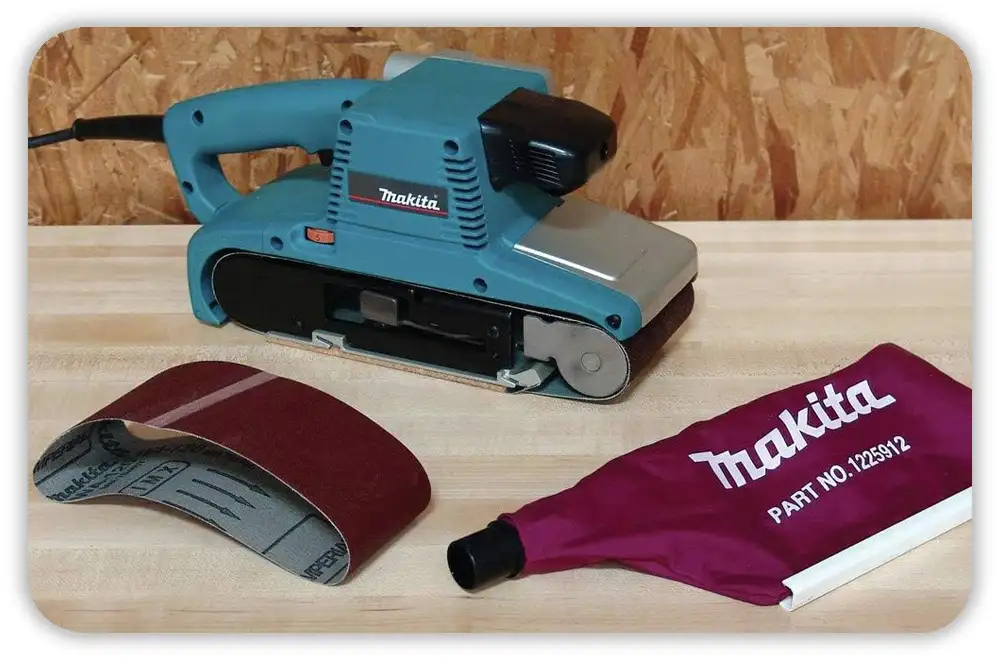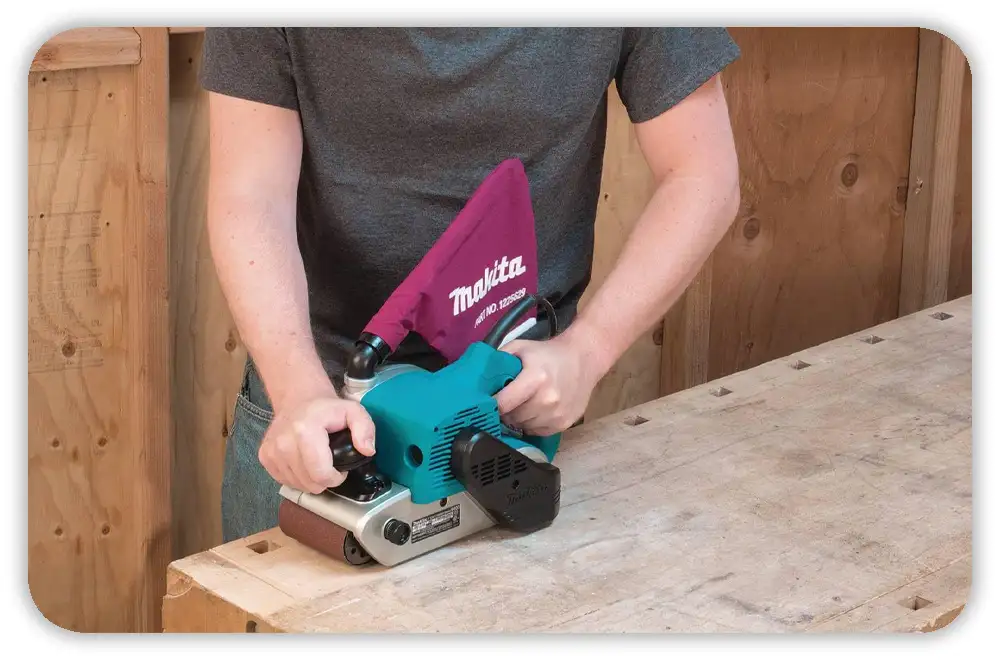Choosing between two belt sanders sounds easy — until you’re in a hot Florida garage or a cold Midwest shop. That’s when power and control really matter.
In this post, I’ll break down the Makita 9403 vs 9404. I’ve used both on real wood, not just read about them online.
At first glance, they look the same. But they don’t feel the same in use. One packs strong power for fast sanding. The other gives you smooth control with variable speed — perfect for fine work like trim or cabinets.
Here’s what I found after testing both side by side with my DeWalt and Milwaukee tools.
Table of Contents
What’s the Main Difference Between the Makita 9403 and 9404?
At first glance, the Makita 9403 and 9404 look almost the same. Both use a 4″ × 24″ belt, have a tough build, and come in that classic Makita teal. But once you start sanding, they feel very different.

The 9403 is built for raw power. Its 11-amp motor and fixed 1,640 FPM speed tear through wood fast. It’s great when you need to remove a lot of material.
The 9404, on the other hand, focuses on control. It has an 8.8-amp motor, variable speed, and can even run upside down for bench sanding. Both cost about the same in U.S. stores like Home Depot or Acme Tools. So the real choice isn’t price—it’s how you work. One is for power, the other for precision.
Quick Comparison Table (Specs at a Glance)
| Feature | Makita 9403 | Makita 9404 |
| Motor | 11 AMP | 8.8 AMP |
| Speed | Fixed 1,640 FPM | Variable 690–1,440 FPM |
| Weight | 12.6 lbs | ~10.3 lbs |
| Best For | Heavy removal, floors, slabs | Precision, cabinetry, trim work |
| Price | Same across most U.S. retailers | Same across most U.S. retailers |
This table shows that while both look alike, they behave very differently once you start sanding.
Who Is the Makita 9403 Best For?

When Power Matters Most
The Makita 9403 is my go-to when I need to move fast. It’s ideal for floor work, decks, and rough slabs. It grinds off paint, rust, and thick hardwood without slowing down. At 12.6 pounds, its weight helps the belt stay flat, so I don’t need to push hard. That makes long sanding jobs easier on my arms. If you want speed and strength, the 9403 is your tool.
Real-World Example
I once used the 9403 on a rough oak slab from an old Midwest barn. The board was uneven and full of knots. Even with a 60-grit belt, the sander never stalled. It stayed smooth and steady the whole time. That’s when I knew this tool was more than strong—it was reliable under pressure.
Who Should Choose the Makita 9404 Instead?
Built for Control and Precision
The Makita 9404 is for people who like smooth, careful sanding. Its variable speed (690–1,440 FPM) keeps it gentle on thin wood, veneers, and cabinets. The auto-tracking belt means I don’t have to stop to adjust it. Its flat top lets me clamp it upside down for small parts, too. For furniture makers or trim carpenters, this model feels calm and easy to handle.
Real-World Example
I used the 9404 on maple cabinets in a dry Arizona home. I turned the speed down to avoid burns on the edges. The slower belt kept the finish clean and cool. No marks, no damage—just smooth wood. That’s something the 9403 would have a hard time doing. The 9404 makes delicate sanding simple and safe.
Power and Performance — Is the Makita 9403 Really Stronger?

Torque and Constant-Speed Control
Yes, the Makita 9403 is stronger. Its 11-amp motor keeps steady torque even when you press hard on rough wood. The fixed 1,640 FPM speed stays fast and smooth, even on dense oak or pine. That’s why I grab it when I need to remove a lot of material fast. The simple truth: the 9403 keeps power steady under pressure.
When Speed Becomes a Problem
That same power can be tricky on soft or thin wood. I’ve burned maple and cherry when I didn’t slow my passes. The belt moves so fast that one bad angle can leave a gouge. On plywood or veneer, it can even sand through the top layer before you notice. So, the 9403 is great for tough jobs—but it needs care on gentle work.
Is the Makita 9404 Better for Detail and Finish Work?
Variable Speed Advantages
Yes, the Makita 9404 is better for detail work. It’s made for control, not raw power. The speed dial lets you slow it to 690 FPM—perfect for thin hardwood, laminate, or finished pieces. At lower speeds, it avoids burning and keeps the belt from clogging. That’s something the 9403 can struggle with.
The 9404 really shines on trim, stairs, and cabinet parts. In smaller shops or home garages, that control helps avoid costly mistakes. It’s also great in dry climates like Arizona, where heat can build fast. In short, the 9404 gives smooth, safe sanding when accuracy matters most.
Ergonomics — Which One Is Easier to Hold and Use All Day?
Weight Difference
The Makita 9403 weighs about 12.6 pounds. That weight helps on flat work like floors and tabletops—it adds pressure for you. But it’s tiring on walls or overhead jobs. The 9404 weighs around 10.3 pounds, and that small difference feels big after a few hours. It’s easier on the arms and shoulders, especially when sanding cabinets or trim. So, the 9403 is stable but heavy, while the 9404 is lighter and more comfortable.
Noise and Vibration
Both sanders run around 84 dB—quiet for their class. Still, hearing protection is smart, especially in small shops. Vibration is low on both, but the 9404 feels smoother at slow speeds. The 9403 can shake more at odd angles because of its weight and fixed speed. The takeaway: both are fairly quiet, but ear protection and a steady hand make long sanding safer and easier.
What Special Features Make the Makita 9404 More Versatile?
The Makita 9404 may not be the strongest, but it’s the most flexible. It’s great for people who switch between rough sanding and fine work in the same day. If you work in a home garage, cabinet shop, or do trim on-site, this sander adjusts fast. That’s why I grab it when I need control and flexibility, not raw power.
Auto-Tracking Belt System
One of the best parts of the 9404 is the auto-tracking belt. You don’t need to stop and re-center the belt every few minutes. It stays straight on its own, even near corners and edges. This saves time and prevents gouges when sanding stairs, doors, or plywood. The key takeaway: it keeps you sanding, not adjusting.
Flat Top for Bench-Mounted Use
The 9404 also has a flat top, so you can clamp it upside down and use it like a mini bench sander. This helps when shaping trim ends or small cabinet pieces. I’ve done this on my workbench with two clamps, and it held steady. It’s a big plus for small shops or garages with limited space. In short, the 9404 acts like two tools in one — handheld and stationary.
What Makes the Makita 9403 More Durable?
While the 9404 wins in flexibility, the Makita 9403 wins in toughness. It’s built to handle real jobsite abuse. I’ve used it in barns, on decks, and near concrete walls where dust flies everywhere. Even then, it runs smooth. If you work in construction, mills, or floor sanding across any U.S. climate, that durability makes a difference.
Labyrinth Construction
The 9403 uses Makita’s labyrinth construction, which seals the motor and bearings from dust. It blocks fine sawdust, debris, and grit that can ruin other sanders. I’ve seen cheaper ones fail after a few months, but this one just keeps going. That design helps it last longer in tough shops or job sites where dust control isn’t perfect. The point is simple: the 9403 is built to survive rough work.
360° Swivel Dust Bag
Another great feature is the 360-degree swivel dust bag. It moves with you while you sand, so it doesn’t get stuck or pull on your arm. When sanding long boards or wide tables, it stays out of the way. It’s a small detail, but it makes sanding faster and smoother. I find it most useful in narrow hallways or tight corners in older homes. In short, the dust setup adds comfort and convenience to heavy jobs.
Price Comparison — Is One Cheaper?
No — there’s no clear price winner. Both the Makita 9403 and 9404 usually sell for around $399 to $419 at places like Home Depot, Acme Tools, and Amazon. I’ve checked during sales, and the difference is rarely more than a few dollars. So price shouldn’t decide for you.
What really matters is how you work. If you sand floors, beams, or slabs all day, go with the 9403. If you build furniture, cabinets, or do detailed trim work, the 9404 is the smarter buy. The bottom line: your workflow — not your wallet — should guide your choice.
Makita 9403 vs 9404 — Which One Should You Buy?
If you’re still unsure between the Makita 9403 and 9404, here’s the simple truth. Both cost about the same, so the choice depends on how you work.
The 9403 is built for raw power and long sanding sessions. The 9404 is made for control, fine detail, and smaller spaces. Pick the one that fits your daily jobs, not just the specs.
| If You… | Go With |
| Sand hardwood floors, slabs, or beams daily | Makita 9403 |
| Build cabinets, furniture, or finish trim | Makita 9404 |
| Need inverted sanding or variable speed | Makita 9404 |
| Want maximum torque and durability | Makita 9403 |
Choose the 9403 if power is your goal, and the 9404 if precision matters more.
FAQs — Quick Answers for the Makita 9403 vs 9404
Is the Makita 9403 more powerful than the 9404?
Yes. The 9403 has an 11-amp motor, while the 9404 runs on 8.8 amps. That extra power keeps speed steady on rough hardwood or paint. Simply put, the 9403 gives more torque and faster removal.
Can the Makita 9404 be used upside down as a bench sander?
Yes. Its flat top lets you clamp it upside down on a workbench. I use this setup for sanding trim or small cabinet parts. It works like a small bench sander and saves space in a garage or shop.
Is variable speed worth it on a belt sander?
Definitely. Slower speeds on the 9404 protect softwood, veneer, and fine finishes. You avoid burns, gouges, and clogs. It’s great for indoor or detailed work where control is key.
Is the Makita 9403 too aggressive for beginners?
It can be. The fixed high speed removes wood fast, so mistakes happen quicker. With a little practice, it’s powerful and reliable, but new users may find the 9404 easier to start with.
Final Verdict — Power or Precision?
Here’s the bottom line in under a minute:
Choose the Makita 9403 if you want max power, speed, and toughness for floors, slabs, or outdoor work.
Pick the Makita 9404 if you build cabinets, furniture, or trim and need control more than force.
Both cost the same, so let your workflow—not your wallet—decide.

